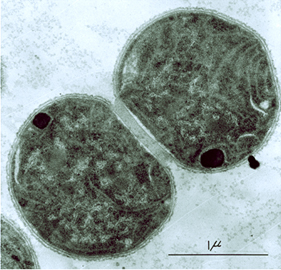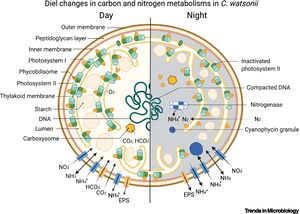Crocosphaera watsonii: Difference between revisions
No edit summary |
|||
| (22 intermediate revisions by the same user not shown) | |||
| Line 1: | Line 1: | ||
{{Uncurated}} | |||
[[Image:Croc watsonii 1.jpg|thumb|300px|right|Crocosphaera watsonii. Image credit: Zehr, J. P., J. B. Waterbury, P. J. Turner, J. P. Montoya, E. Omoregie, G. F. Steward, A. Hansen, and D. M. Karl..]] | |||
==Classification== | ==Classification== | ||
Bacteria; Cyanobacteria; Oscillatoriophycideae; Chroococcales; Aphanothecaceae; Crocosphaera | |||
Bacteria; Cyanobacteria; Oscillatoriophycideae; Chroococcales; Aphanothecaceae; Crocosphaera | |||
===Species=== | ===Species=== | ||
{| | |||
| height="10" bgcolor="#FFDF95" | | |||
https:// | '''NCBI: [https://www.ncbi.nlm.nih.gov/Taxonomy/Browser/wwwtax.cgi?mode=Info&id=263511&lvl=3&lin=f&keep=1&srchmode=1&unlock]''' | ||
|} | |||
''Crocoshaera watsonii'' | |||
==Description and Significance== | ==Description and Significance== | ||
Crocosphaera watsonii is a diazotrophic marine cyanobacteria. They are unicellular nitrogen fixers that help turn nitrogen in the atmosphere into ammonia, restoring the circulation of nitrogen in the oceans | Crocosphaera watsonii is a diazotrophic marine cyanobacteria. They are unicellular nitrogen fixers that help turn nitrogen in the atmosphere into ammonia, restoring the circulation of nitrogen in the oceans. | ||
They are found in warm water conditions where the water temperature is above 24 degrees Celcius. These bacteria mostly reside in places that have low plant nutrients and a high abundance of dissolved oxygen. In regions of the oceans where there are low levels of nitrogen available, primary photosynthesis and production are limited. C. watsonii are very abundant in these regions and contribute a large amount of nitrogen in these areas. | |||
They are | These cyanobacteria are one of the main components involved with marine phytoplankton. They are especially important in oligotrophic waters where they are the only source of primary production. | ||
==Genome Structure== | ==Genome Structure== | ||
Crocosphaera watsonii has six genomes with an average length of 5.885 Mbp. C. watsonii has many different strains that each contain a phenotypic difference. However, the majority of the DNA sequences from the strains are found to be nearly identical to one another. Through culturing and sequence conservation, studies have found that the strains have been able to maintain genetic diversity through divergence and | Crocosphaera watsonii has six genomes with an average length of 5.885 Mbp. C. watsonii has many different strains that each contain a phenotypic difference. However, the majority of the DNA sequences from the strains are found to be nearly identical to one another. Through culturing and sequence conservation, studies have found that the strains have been able to maintain genetic diversity through divergence and rearrangement. | ||
One strain of C. watsonii, WH8501, showed that the mobile genetic elements, like transposase genes, have provided ways for the bacteria to mutate through genetic insertions and deletions, and through rearrangement. | |||
These mobile genetic materials are what separates C. Watsonii from other marine cyanobacteria such as Prochlorococcus which lacks transposase genes and normally has a higher diversity sequence than C. Watsonii. | These mobile genetic materials are what separates C. Watsonii from other marine cyanobacteria such as Prochlorococcus which lacks transposase genes and normally has a higher diversity sequence than C. Watsonii. | ||
The strains cultivated from C. Watsonii can be divided into two main phenotypic categories: those that are bigger than 4.0um in diameter and those that produce excess amounts of ESP, or exopolysaccharide that are attached to a slime layer on the microorganism and help protect against external factors. Bacteria bigger 4.0um usually do not show large amounts of ESP compared to smaller microbes. | The strains cultivated from C. Watsonii can be divided into two main phenotypic categories: those that are bigger than 4.0um in diameter and those that produce excess amounts of ESP, or exopolysaccharide that are attached to a slime layer on the microorganism and help protect against external factors. Bacteria bigger than 4.0um usually do not show large amounts of ESP compared to smaller microbes. | ||
==Cell Structure, Metabolism and Life Cycle== | ==Cell Structure, Metabolism and Life Cycle== | ||
C. Watsonii contains multiple thylakoid membranes located near the cytoplasmic membrane that is arranged in a lot of twisting clusters. It has a semipermeable cell membrane and starch granules that form barriers to oxygen gas. | C. Watsonii contains multiple thylakoid membranes located near the cytoplasmic membrane that is arranged in a lot of twisting clusters. It has a semipermeable cell membrane and starch granules that form barriers to oxygen gas. | ||
Their metabolic rates and activities are very sensitive to abiotic factors such as temperature, causing them to only inhabit warm waters. | |||
Crocosphaera watsonii has a 35-hour doubling time. In the warm parts of the Atlantic and Pacific oceans, Crocosphaera watsonii has been found to have cell densities of above 1000 cells per milliliter. | Crocosphaera watsonii has a 35-hour doubling time. In their natural environments, these microbes can reach very high cell densities because of their rapid growth rate. In the warm parts of the Atlantic and Pacific oceans, Crocosphaera watsonii has been found to have cell densities of above 1000 cells per milliliter. | ||
When segregating nitrogen fixation from oxygenic photosynthesis, these microbes are able to protect an enzyme called nitrogenase, one of the main enzymes responsible for nitrogen fixation. | |||
[[Image:C. watsonii 2.jpg|thumb|300px|right|C. watsonii cell structure. Image credit: Cell Press]] | |||
==Ecology== | |||
C. watsonii is abundant in tropical oceans where it fixes carbon during the day and nitrogen at night. They can exist as individual cells or a colony of cells bound by EPS, extracellular polymeric substances. Through these processes, they are able to contribute to the biogeochemical cycles around the world. C. watsonii is able to reduce nitrogen gas into organic compounds. | |||
These microorganisms can compete with other types of cells for compounds that combine with nitrogen such as ammonium, nitrate, and urea. | |||
[[Image:C. watsonii 4.webp|thumb|300px|right|C. watsonii Carbon and Nitrogen Cycles. Image credit:Jack Cook, Woods Hole Oceanographic Institution]] | |||
==References== | ==References== | ||
Home - Crocosphaera Watsonii WH8501. (n.d.). Retrieved November 25, 2022, from https://genome.jgi.doe.gov/portal/crowa/crowa.home.html | Bench SR, Heller P, Frank I, Arciniega M, Shilova IN, Zehr JP. Whole genome comparison of six Crocosphaera watsonii strains with differing phenotypes. J Phycol. 2013 Aug;49(4):786-801. doi: 10.1111/jpy.12090. Epub 2013 Jul 9. PMID: 27007210; PMCID: PMC5945289 | ||
Home - Crocosphaera Watsonii WH8501. (n.d.). Retrieved November 25, 2022, from https://genome.jgi.doe.gov/portal/crowa/crowa.home.html | |||
Inomura, K. I., Deutsch, C., & Wilson, S. T. (2019, December 11). Quantifying oxygen management and temperature and light dependencies of ... Retrieved November 26, 2022, from https://journals.asm.org/doi/abs/10.1128/msphere.00531-19 | |||
Inomura, K | Inomura, K., Mares, J., & Prasil, O. (2022, March 21). Higher-order microbiome interactions and how to Find them: Trends in ... Trends In Microbiology. Retrieved December 13, 2022, from https://www.cell.com/trends/microbiology/fulltext/S0966-842X(22)00089-0 | ||
Repeta Group. (n.d.). Retrieved December 12, 2022, from https://www2.whoi.edu/site/repetagroup/specdrom/phytoplankton-cultures/crocosphaera-watsonii/ | |||
==Author== | ==Author== | ||
Latest revision as of 04:12, 13 December 2022
Classification
Bacteria; Cyanobacteria; Oscillatoriophycideae; Chroococcales; Aphanothecaceae; Crocosphaera
Species
|
NCBI: [1] |
Crocoshaera watsonii
Description and Significance
Crocosphaera watsonii is a diazotrophic marine cyanobacteria. They are unicellular nitrogen fixers that help turn nitrogen in the atmosphere into ammonia, restoring the circulation of nitrogen in the oceans.
They are found in warm water conditions where the water temperature is above 24 degrees Celcius. These bacteria mostly reside in places that have low plant nutrients and a high abundance of dissolved oxygen. In regions of the oceans where there are low levels of nitrogen available, primary photosynthesis and production are limited. C. watsonii are very abundant in these regions and contribute a large amount of nitrogen in these areas.
These cyanobacteria are one of the main components involved with marine phytoplankton. They are especially important in oligotrophic waters where they are the only source of primary production.
Genome Structure
Crocosphaera watsonii has six genomes with an average length of 5.885 Mbp. C. watsonii has many different strains that each contain a phenotypic difference. However, the majority of the DNA sequences from the strains are found to be nearly identical to one another. Through culturing and sequence conservation, studies have found that the strains have been able to maintain genetic diversity through divergence and rearrangement.
One strain of C. watsonii, WH8501, showed that the mobile genetic elements, like transposase genes, have provided ways for the bacteria to mutate through genetic insertions and deletions, and through rearrangement. These mobile genetic materials are what separates C. Watsonii from other marine cyanobacteria such as Prochlorococcus which lacks transposase genes and normally has a higher diversity sequence than C. Watsonii.
The strains cultivated from C. Watsonii can be divided into two main phenotypic categories: those that are bigger than 4.0um in diameter and those that produce excess amounts of ESP, or exopolysaccharide that are attached to a slime layer on the microorganism and help protect against external factors. Bacteria bigger than 4.0um usually do not show large amounts of ESP compared to smaller microbes.
Cell Structure, Metabolism and Life Cycle
C. Watsonii contains multiple thylakoid membranes located near the cytoplasmic membrane that is arranged in a lot of twisting clusters. It has a semipermeable cell membrane and starch granules that form barriers to oxygen gas.
Their metabolic rates and activities are very sensitive to abiotic factors such as temperature, causing them to only inhabit warm waters.
Crocosphaera watsonii has a 35-hour doubling time. In their natural environments, these microbes can reach very high cell densities because of their rapid growth rate. In the warm parts of the Atlantic and Pacific oceans, Crocosphaera watsonii has been found to have cell densities of above 1000 cells per milliliter.
When segregating nitrogen fixation from oxygenic photosynthesis, these microbes are able to protect an enzyme called nitrogenase, one of the main enzymes responsible for nitrogen fixation.
Ecology
C. watsonii is abundant in tropical oceans where it fixes carbon during the day and nitrogen at night. They can exist as individual cells or a colony of cells bound by EPS, extracellular polymeric substances. Through these processes, they are able to contribute to the biogeochemical cycles around the world. C. watsonii is able to reduce nitrogen gas into organic compounds.
These microorganisms can compete with other types of cells for compounds that combine with nitrogen such as ammonium, nitrate, and urea.
References
Bench SR, Heller P, Frank I, Arciniega M, Shilova IN, Zehr JP. Whole genome comparison of six Crocosphaera watsonii strains with differing phenotypes. J Phycol. 2013 Aug;49(4):786-801. doi: 10.1111/jpy.12090. Epub 2013 Jul 9. PMID: 27007210; PMCID: PMC5945289
Home - Crocosphaera Watsonii WH8501. (n.d.). Retrieved November 25, 2022, from https://genome.jgi.doe.gov/portal/crowa/crowa.home.html
Inomura, K. I., Deutsch, C., & Wilson, S. T. (2019, December 11). Quantifying oxygen management and temperature and light dependencies of ... Retrieved November 26, 2022, from https://journals.asm.org/doi/abs/10.1128/msphere.00531-19
Inomura, K., Mares, J., & Prasil, O. (2022, March 21). Higher-order microbiome interactions and how to Find them: Trends in ... Trends In Microbiology. Retrieved December 13, 2022, from https://www.cell.com/trends/microbiology/fulltext/S0966-842X(22)00089-0
Repeta Group. (n.d.). Retrieved December 12, 2022, from https://www2.whoi.edu/site/repetagroup/specdrom/phytoplankton-cultures/crocosphaera-watsonii/
Author
Page authored by Ashleigh Wright, student of Prof. Bradley Tolar at UNC Wilmington.



